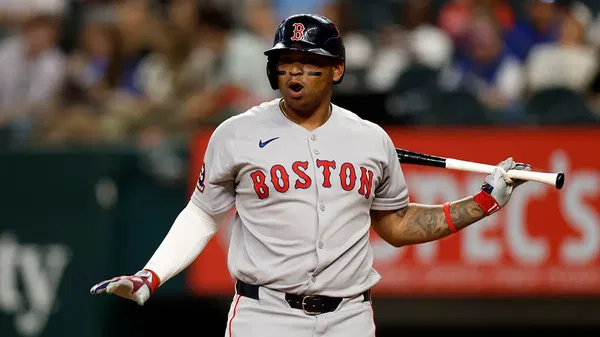

The sound of breaking bats and warm April light air usually mean one thing—baseball’s back. But the spring brought more questions than confidence for one AL East team. Whispers went louder as eyes narrowed on a key figure who did not look at himself.
It wasn’t just the box score that elevated the brows—it was the body language, the swing mechanics, the sluggish beginning. Before long, it wasn’t just fans taking notice. A former star from the same clubhouse stepped in with a blistering on-air assessment, challenging everything from preparation to mindset.
That spotlight? It is falling right on Rafael Devers. Once the shrilling heartbeat of the Red Sox lineup, Devers entered 2025 not at third base, but in a role that felt strange: designated hitter. And while the move might’ve been tactical on paper, the early results have escalated more red flags than reassurance. Through 11 games, Devers has looked like a grenade of his 2024 self—batting .244 with just 1 home run and 17 strikeouts in 41 at-bats. Contrast that to last season when he slugged 28 homers, racked up 143 hits, and posted a robust .871 OPS. The variation? Night and day.
ADVERTISEMENT
Article continues below this ad
Red Sox closer Jonathan Papelbon did not stop when discussing Rafael Devers’ new role. “I don’t think he came into spring training in shape”, he said bluntly on NESN. “I do not think he was mentally or physically prepared for this DH job“. The critique was not just from the gut—an examination from NESN showed Devers’ swing was about six miles per hour slower than the previous season. For a guy known for punishing mistake pitches, missing dead-center fastballs was not just off—it was alarming. Papelbon’s verdict hits firm: “He was in his head… in his own space to be, ‘I am a DH”.
The issue is not just mechanics—it is the frame of mind. Becoming a full-time DH needs more than moving into the batter’s box a few times a game. There is downtime, new routines and a distinctive flow—and not many players just don’t thrive in that space. For Devers, who spent years holding sway over third base with his glove and bat, the changeover looked jarring. His timing was off, his power yield flat, and his swing discipline irregular. Despite a respectable .373 OBP, his slugging percentage has reduced to .390—far from the .516 mark he posted in 2024. He’s still drawing walks, yes, but the feared, dominant version of Devers hasn’t fully exhibited yet.
Yet, amid the slow start, there is a vague sign of recalibration. The swing looks tighter, he is taking better hacks, and his approach looks to be stabilizing. His early wRC of 117 shows he’s still producing above league average, though not at his usual elite spot. If the wake-up call sparked something, supporters might still get the Devers they’ve come to expect. But for now, the doubts remain—and the load of proving otherwise is his alone.
The Red Sox’s DH dilemma
The designated hitter spot has long been seen as a power locus, but it is also one of baseball’s most mentally demanding parts. Ask around the league, and you will hear it time and again—some guys just aren’t suited to DH full-time. For Devers, who boomed on routine and rhythm at third base, the shift feels like it plundered away the spark. The moments between at-bats can be a mental trap. There’s no fielding to dodge a bad swing, no quick turnaround to stay locked in. Just pacing in the dugout and sitting with your point of view. And if that sounds like maltreatment for a rhythm hitter, that’s because it often is.
The Red Sox didn’t make this move just to trial—they made it out of necessity. With Triston Casas sidelined and corner infield options thin, sliding Devers to DH was a short-term fix focused on safeguarding his bat while plugging defensive holes. But it’s a move that came with high risks. Devers is not a one-dimensional performer; his energy in the field often fed his confidence at the plate. By removing half his game, the Sox may have inadvertently shaken his rhythm. And the bullpen’s depth hasn’t helped—without much protection in the lineup, pitchers are attacking him diversely, and the ramifications are visible.
What’s your perspective on:
Is Rafael Devers' slump a sign of poor preparation, or is the DH role just not for him?
Have an interesting take?
That raises a broader question about how the Red Sox handle transitions for their key players. Shouldn’t a move this significant come with more preparation and support? The club’s front office has been quiet. If Devers doesn’t find his groove soon, a more familiar role could be less about comfort and more related to survivorship.
ADVERTISEMENT
Article continues below this ad

ADVERTISEMENT
Article continues below this ad
Devers’ bat still holds the power, but the role change has rattled the rhythm. If the Red Sox want their talent fully unlocked, they’ll need to reconsider how they manage his role and preparedness. What do you think—does Devers need to go back to third and ride it out at Designated Hitter?
ADVERTISEMENT
ADVERTISEMENT
ADVERTISEMENT
ADVERTISEMENT


Is Rafael Devers' slump a sign of poor preparation, or is the DH role just not for him?